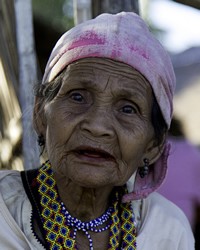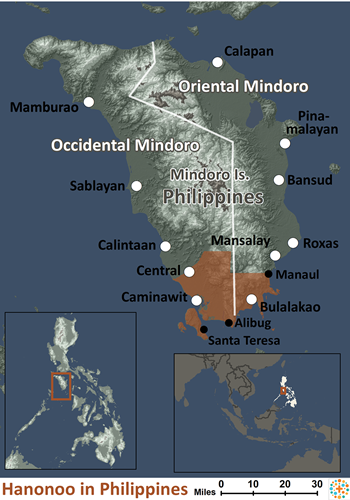The Hanunóo live on Mindoro, a Philippine island located southwest of the main island, Luzon. As residents of Mindoro, the Hanunóo are one of several Mangyan people groups. The Hanunóo primarily speak the Hanunóo (or Hanunó'o) language, and use a writing system called Surat Mangyan, which comes from the ancient Sanskrit alphabet. The Hanunóo write by carving characters on bamboo trunks using bolo knives.
The Hanunóo have historically lived in seclusion, but their private lifestyle has faced challenges in recent decades. Increased migration to the island has prompted the Hanunóo of south central Mindoro to move inland. As a result, many Hanunóo now live in the forested area of Mindoro, away from the coastal lowlands. No roads connect these two areas, but the Hanunóo still make the journey in order to conduct business with those outside their community. The Hanunóo have developed relationships with surrounding people groups and have pursued educational opportunities in hopes of maintaining autonomy.
The Hanunóo have historically lived in hamlets consisting of clusters of households with fields dispersed nearby. These settlements are smaller than typical towns or villages. Recently, the Philippine government has encouraged the Hanunóo to adopt a village lifestyle, although this has brought challenges, including sanitation issues and scarcity of resources. Many have left their villages to return to their previous lifestyles.
The Hanunóo mostly grow their food through “slash-and-burn” farming. In this method, a section of forest is cut down, the plant debris is burned, and crops are planted in the resulting clearing. The Hanunóo have also utilized different farming practices with a focus on sustainability. The Hanunóo grow several crops, including corn, sweet potatoes, bananas and rice. The farming practices of the Hanunóo are also accompanied by rituals and traditions.
The Hanunóo are artisans, known for their intricately woven cotton goods and their hand-embroidered clothing, which includes shirts and loincloths for men and skirts and blouses for women. Typically, men create weapons, such as knives and axes, while women design cotton goods and make baskets. The Hanunóo play music while making things. Traditional instruments include the three-stringed fiddle, flute and bamboo harp. The Hanunóo also play music during religious rituals and when courting. Men and women court by performing harana, a traditional Filipino courtship practice that involves a man singing love poems to a woman. Upon marrying, the husband lives with his wife's family to make up for the debt he has incurred by marrying their daughter.
Beads play an important role in Hanunóo culture. Men and women alike wear bead necklaces and bracelets, but they also use beads for several other purposes. The Hanunóo use beads for religious purposes, settling disputes, paying fines and more.
The Hanunóo are animists, which means they believe animals and aspects of nature have spirits. Notably, the Hanunóo believe in guardian spirits, called kalag, which one must appease by obeying legal rules and making offerings of food and glass beads. If the kalag are angry, they send evil spirits, known as labang, to afflict the Hanunóo. These spirits cause illness or death. To combat illness, the Hanunóo call in a shaman or priest, known in their language as a balyanan. The balyanan have control over spirits living in rocks, and they send these spirits to attack the evil spirits that cause illnesses.
The Hanunóo experience many challenges, including land insecurity, food shortages, health issues and a lack of access to education and medicine. Hanunóo who travel to the lowlands for education often feel belittled in their schools and spurned by their home communities. Even greater than their physical needs are their spiritual ones. While some Hanunóo have become Christians, many still need to learn of the hope that is available through Jesus Christ. They also need Christian materials translated into their language. Much prayer and further evangelism are keys to reaching these precious people with the gospel.
Pray for God to call Christian educators, doctors and other laborers to Mindoro.
Pray that Christian evangelical materials will be translated into the Hanunóo language.
Pray for God to give Hanunóo believers boldness and favor as they seek to share the love of Jesus with their communities.
Pray for God to grant repentance to those among the Hanunóo who do not follow Jesus.
Scripture Prayers for the Hanunoo in Philippines.
https://www.culturalsurvival.org/publications/cultural-survival-quarterly/pundasyon-Hanunóo-mangyan-school-participatory-education
https://folkways.si.edu/Hanunóo-music-from-the-philippines/world/album/smithsonian
https://www.ethnologue.com/language/hnn/
http://www.ethnicgroupsphilippines.com/ethnic-groups-in-the-philippines/hanunoo/
https://masipag.org/the-hanunoo-and-their-mission-to-enrich-their-ancestral-domain-thru-sustainable-agriculture/
| Profile Source: Joshua Project |

























